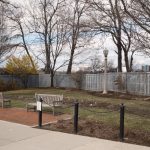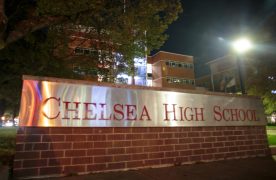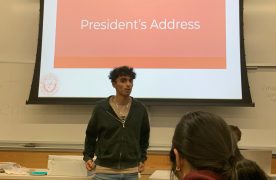Despite the rain, over 3,500 people gathered April 26 to clear trash and invasive plants from green spaces surrounding the Charles River and its tributaries.
The Earth Day Charles River Cleanup, hosted annually since 1999, is one of the largest river cleanups in the county.

As a part of the American Rivers’ National River Cleanup initiative, it aims to get the community involved in preserving the areas around the Charles, according to a press release.
Volunteers gathered at Olmsted Park, where they collected over a ton of trash last year in a single day, said Declan Battles, marketing and communications director of the Emerald Necklace Conservancy.
“No one likes parks with litter in them. No one likes geese and turtles with those plastic rings around their necks,” Battles said. “We are very grateful to be part of the community that is very passionate about their parks, that wants to come out here, rain or shine, and clean them.”
The rain was not enough to stop volunteer Heather Ivester, who came out to the event after it was brought up to her from the sustainability lead at her job.
“I saw it was raining this morning … I thought, geez, should I go? And my daughter said, ‘you really should go and participate. I think it’s important to help out with Earth’s birthday,’” she said.
Battles said the event was a rain or shine event.
“We all know that getting into it, so we just roll with the punches,” said Battles. “If the volunteers are expected to be out here in the rain, then so are we.”
Battles said parks are vital in preserving green spaces and allowing people to enjoy nature in city spaces.
“A lot of people want to give back to the parks that do a lot for us,” he said. “They are a [means] of recreation for people that don’t otherwise have the ability to get out of the city.”
For volunteers, the clean up gave them the opportunity to take actionable steps to celebrate Earth Day.
“We only have one Earth, and if we fill it with lots of trash, it affects all the animals and the plants,” said scientist and volunteer Julia Jones, who found the event through a signup link her coworker posted. “We want to do something for Earth Day, so why not clean up at a local park?”
Volunteer Lada Flippov said she was looking for Earth Day events online when she came across the cleanup.
“I’ve always loved Earth Day and I’ve always felt like I couldn’t really do enough,” she said. “I just end up looking through pictures on my phone of the Earth, and this [cleanup] is just better than that.”
Algis Petlin, who was also volunteering, said the event was a great way to give back to Brookline’s community.
Petlin and Flippov hail from the same hometown that also hosted similar cleanup events in their community.
“We can see how much of an impact it has [where] we come from, a smaller town. But do you know the impact that can have on a [bigger] scale?” said Petlin.
Boston University freshman Ananth Krishnan said his WR153 class required him to attend a volunteering event, and he chose the Charles River Cleanup after noticing trash around the park while walking in the area.
“I feel like as a community, it makes us feel like we’re giving back and making the green areas around us better,” he said.
At the end of the Olmsted Park cleanup, the group gathered around 30 trash bags of trash, according to Battles.
In addition to trash collection, park ranger Emma Palermo trained volunteers to identify and remove invasive plants like multiflora rose, Japanese knotweed and oriental bittersweet.
“These plants don’t really contribute anything to the river and the wildlife in this area … they just get in the way of other non-invasive [plants],” volunteer Marcus Glynn said. “When you’re in a city like this, it’s not common to have a lot of these areas around, so keeping them clean is vitally important.”
Palermo told volunteers it takes a few days for her and her colleague to remove all the knotweed in the park — this year it only took them around 20 minutes.
While it’s inevitable that more trash will pollute the park, Battles highlighted the effort that people put in beyond cleanup days to keep public spaces clean.
“It’s a lot of hands and a lot of passion that people involved that are working year round to keep this clean,” he said. “It was kind of a Sisyphean task. It’s one that’s very gratifying for all of us involved.”












